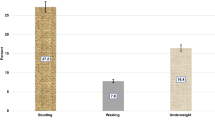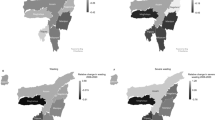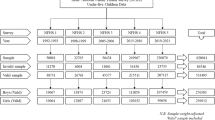Abstract
Objective: The aim of the study was to examine the relationships between nutritional status and diarrhoea and respiratory infections.
Design: Prospective cohort study within the framework of a randomized double-blind placebo-controlled intervention trial.
Setting: In rural communities in the Khartoum and Gezira regions, in Northern Sudan.
Subjects: 28, 753 Sudanese pre-school children between 6 months and 6 y old.
Methods: Relative risks of subsequent diarrhoea and respiratory infections in relation to nutritional status measured by anthropometry (Z-scores of height-for-age (H/A), weight-for-height (W/H), and weight-for-age (W/A), which reflect stunting, wasting and underweight, respectively) were estimated using odds ratios from logistic regression adjusting for various covariates.
Results: H/A, W/H and W/A were significantly and inversely associated with subsequent diarrhoea and febrile diarrhoea (P for trend <0.001) with risks being 2.00 times higher (95% confidence interval, CI (1.64, 2.43)) among children with W/A Z-scores below −4 Z, and 1.75 times higher (95% CI (1.56, 1.96)) among those with a W/A Z-score between −4 and −3 Z compared with children having a W/A Z-score ≥1. Age, gender, region of residence and seasonality modified these associations. Also, febrile cough was inversely associated with W/A and W/H (P<0.03), with risks ranging from 1.41 times higher (95% CI (1.02, 1.97)) to 1.21 times higher (95% CI (1.04, 1.41)) in the group of underweight children with W/A Z-scores below −4 and between −2 and −1 Z, all compared with normally nourished children (≥−1 Z).
Conclusions: The reduction of severe but also mild and moderate undernutrition is necessary through nutrition, health and socio-economic improvement in order to prevent morbidity.
Sponsorship: This study was carried out under cooperative agreement no. DAN-00450G-SS-6067 of the Office of Nutrition, US Agency for International Development, Washington DC, and the Harvard Institute for International Development.
European Journal of Clinical Nutrition (2000) 54, 463–472
This is a preview of subscription content, access via your institution
Access options
Subscribe to this journal
Receive 12 print issues and online access
$259.00 per year
only $21.58 per issue
Buy this article
- Purchase on Springer Link
- Instant access to full article PDF
Prices may be subject to local taxes which are calculated during checkout
Similar content being viewed by others
Author information
Authors and Affiliations
Contributions
Guarantors: P Nestel, MG Herrera and WW Fawzi.
Contributors: JK contributed to the design of this analysis, prepared the drafts of the paper and did the statistical analysis. P Nestel designed and implemented the field study, MH and with WF initiated the study, and provided advice in data analysis and commented on the manuscript. A El-A contributed to the implementation of the study in the field.
Rights and permissions
About this article
Cite this article
Kossmann, J., Nestel, P., Herrera, M. et al. Undernutrition in relation to childhood infections: a prospective study in the Sudan. Eur J Clin Nutr 54, 463–472 (2000). https://doi.org/10.1038/sj.ejcn.1600998
Received:
Revised:
Accepted:
Published:
Issue Date:
DOI: https://doi.org/10.1038/sj.ejcn.1600998
Keywords
This article is cited by
-
Water and sanitation associated with improved child growth
European Journal of Clinical Nutrition (2003)



